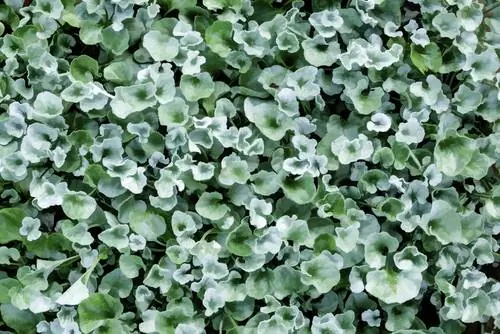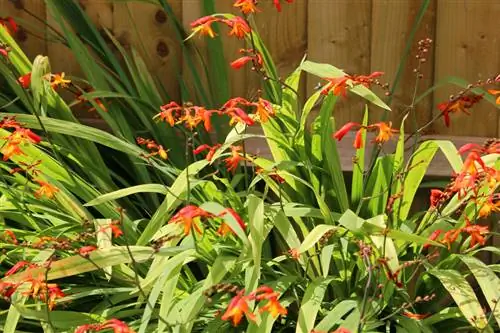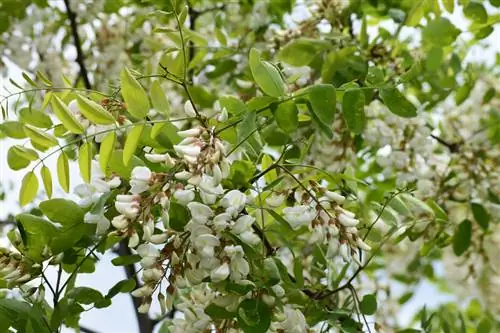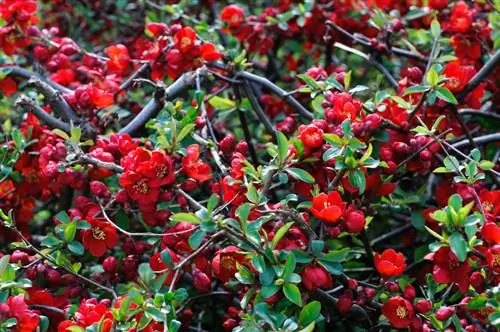- Author admin [email protected].
- Public 2023-12-25 17:45.
- Last modified 2025-01-23 11:21.
The silver rain owes its poetic name to its characteristic growth form on the one hand and to the unusual leaf coloring on the other. The densely packed leaves have a striking, silvery color, which makes the plant look like a shiny waterfall thanks to its hanging shoots, which are up to 150 centimeters long. Silver rain is primarily cultivated as a balcony or house plant and looks best in hanging baskets. With the right care, you can enjoy the vigorous morning glory plant for a long time.

What is silver rain and how do I care for it?
Silver Rain is a cultivar of Dichondra argentea, which is known for its silvery, hanging shoots. It thrives best in warm, sunny to partially shaded locations and requires well-drained, nutrient-rich soil. As a balcony or house plant, it is easy to care for and non-toxic.
Origin and distribution
The Silver Rain is not a separate species, but a particularly striking cultivar of the Dichondra argentea species, which is widespread in the south of the USA and in Central and South America. This belongs to the genus Dichondra, which includes around 15 species, which in turn is part of the morning glory family (bot. Convolvulaceae) and is related to the sweet potato (bot. Ipomoea batatas).
The various Dichondra species are almost exclusively native to the tropical and subtropical regions of Central and South America; only two species - Dichondra repens and Dichondra brevifolia - can also be found in New Zealand and Australia. As a neophyte, Dichondra micrantha, originally native to Texas, Mexico and the Caribbean islands, is spreading in southern Europe, where the species is often sown over large areas as a lawn replacement.
Appearance and growth
Dichondra argentea 'Silberregen' is a herbaceous plant whose thin shoots, up to one and a half or even two meters long, grow prostrate or drooping. The variety is sometimes referred to as 'Silver Falls'. The plants, usually delivered as young plants or grown yourself, grow quickly and form densely green areas within a few weeks. For this reason, the creeping or hanging plant, which is actually perennial but not sufficiently frost-hardy, can easily be cultivated as an annual.
Usage
Silver rain looks best when planted individually in hanging baskets or balcony boxes, but also decorates walls, ledges, fences and similar structures on the balcony, terrace or in the garden. It is also very popular to use it as a replacement lawn for greening bare open spaces, for example in a perennial bed or as a border.
The shiny silver leaves are particularly highlighted by the association with red or blue to violet-flowering perennials or summer flowers. Dichondra argentea is particularly suitable here as a (hanging) background plant or border. Suitable planting partners are, for example, monkshood (be careful, poisonous!), scented nettle, summer aster, lupine, dyer's pod, delphinium, bellflower, knapweed, carnation, red yarrow, spurflower, foxglove (also poisonous!) or hollyhock.
Dichondra argentea is also ideal as a houseplant, as the tropical plant with its high ornamental value is easy to care for.
leaves
The shiny, silvery, hairy leaves of the silver rain are reminiscent of small coins due to their rounded shape and sit close together on the delicate, long shoots. This creates a compact, dense overall appearance.
Flowers, flowering time and fruits
The small, bright yellow-green bell flowers appear numerous throughout the season, but are quite inconspicuous. After flowering, capsule fruits develop, which usually consist of two separate, membranous capsules with only one round seed each.
Toxicity
Dichondra argentea is non-toxic and therefore ideal for households with small children and curious pets.
Which location is suitable?
As a typical plant of the subtropics and tropics, silver rain likes to be warm: in order to feel comfortable and grow vigorously, the plant needs a temperature of at least 16 degrees Celsius. Below this value, Dichondra argentea stops growing. However, the ideal location should not only be warm, but also protected from wind and rain and, if possible, sunny to partially shaded.
A slightly shady location doesn't hurt, however, as the plant specifically seeks the sunlight thanks to its long shoots. Balcony plants in particular benefit from being planted in shade. Only the shoots should grow in the sun. This measure means that the substrate in the pot does not dry out as quickly and you have to water less.
Soil / Substrate
When it comes to soil, Silver Rain is quite undemanding and thrives excellently on any well-drained, nutrient-rich, sandy-loamy soil - it just needs to be permeable and loose, because the variety needs dryness. For this reason, you should always provide plants grown in pots with good drainage to prevent waterlogging from occurring in the first place. In addition, excess irrigation water must be removed from the planter or saucer immediately after watering. By the way, potted plants feel most comfortable in good humus-based potting soil.
By the way, this description does not apply to all Dichondra species, because some - for example the creeping Dipondra (bot. D. repens), which prefers a rather fresh to moist substrate and must not dry out under any circumstances.
Planting Silver Rain correctly
Since silver rain planted in the garden cannot survive the cold season due to its lack of winter hardiness, you should either buy new young plants every year or prefer them. The seeds can be purchased quite cheaply from specialist retailers.
Advance
From mid-January, sow the seeds in small pots with growing substrate and place them on a bright windowsill at around 22 degrees Celsius. Keep the substrate only slightly moist and avoid moisture, otherwise mold growth will occur. After about two weeks the seedlings will finally start to grow, then you can lower the temperature to around 20 degrees Celsius.
Planting time
From mid to late May, when the temperatures outside are constantly at least 16 degrees Celsius, you can plant the young plants either in the bed or in a larger pot with a more nutrient-rich substrate. Get the plants used to the new location slowly so that there are no irritations.
Alternatively, you can sow the seeds directly outdoors from May onwards, but after that it should not get colder than 16 degrees Celsius.
Planting spacing
If you want to plant silver rain as a ground cover, we recommend a planting distance of at least 20 centimeters. The plants can grow up to 60 centimeters wide and between 15 and 30 centimeters high, which is why the recommended distance should also be maintained in planters such as a flower box. For a balcony box with a length of 60 centimeters, you should plan a maximum of five silver rain plants.read more
Pouring silver rain
In contrast to some other types of dichondra, silver rain only needs a little water and can cope excellently with drought and heat. So only water moderately but regularly and let the substrate dry in between.
Make sure to only water from below and not to wet the leaves and flowers.
Fertilize Silver Rain properly
As annual plants, specimens planted in the garden do not require any fertilizer. However, you should supply silver rain cultivated in pots - which can be overwintered quite easily - between August and September with a liquid fertilizer administered through the irrigation water about every four weeks.
Cut silver rain correctly
If you only cultivate silver rain as an annual, pruning is not necessary. Only if the shoots become too long can you simply shorten them with scissors and otherwise let the fast-growing plant continue to grow. Overwintered specimens, on the other hand, are cut back completely in spring and then sprout again even more beautifully.
Increase silver rain
Silver rain can be easily propagated not only from seeds, but also from cuttings cut in early summer. To do this, cut head cuttings about five centimeters long and put them in small pots with growing substrate. Place the potty in a bright, but not directly sunny, warm place, for example on a windowsill. Keep the substrate slightly moist but not wet. The cuttings form roots within a short time and can be moved to a larger pot or cold frame as soon as new leaves develop.
Wintering
Silver rain planted in the garden is not winter hardy and cannot be overwintered outdoors even with protective measures such as brushwood etc. Therefore, dichondra used as ground cover must be replanted every year. However, specimens grown in pots can be brought through the cold season under the following conditions:
- bright, protected location in the house or winter garden
- Temperatures between ten and 15 degrees Celsius
- at temperatures below 12 degrees Celsius, silver rain stops growth
- Severely reduce watering during the winter
- Let the substrate dry out to a depth of at least two centimeters between waterings
- Stop fertilization completely
In April, cut back the silver rain completely and repot the plant in fresh, nutrient-rich substrate and, if necessary, a larger container. Now slowly start fertilizing again and also slowly increase the amount of water. From mid to late May, the plant can finally be outdoors again, provided the temperatures are consistently above 16 degrees Celsius.
Diseases and pests
The silver rain is considered robust and is rarely attacked by diseases and pests.
Tip
In addition to the variety of the species Dichondra argentea known as 'Silver Rain', there is also a variety of the same name of the hanging bells (bot. Campanula poscharskyana), which are particularly popular as balcony flowers. This bears its poetic name because of the lush, snow-white flowers. In addition, the common black locust is also occasionally referred to as silver rain.
Species and varieties
In addition to the species Dichondra argentea and its variety 'Silberregen', other Dichondra species are also cultivated as ornamental plants. Dichondra micrantha, for example, is used as a ground cover and lawn replacement. Dichondra repens is also cultivated as an ornamental plant and can be used as a lawn replacement or ground cover in gardens. The species is available with green to gray leaves and is sown every year. Dichondra repens is a small, herbaceous plant native to New Zealand and many parts of Australia. It is sometimes called kidneywort and often grows in forest and grassland habitats.






